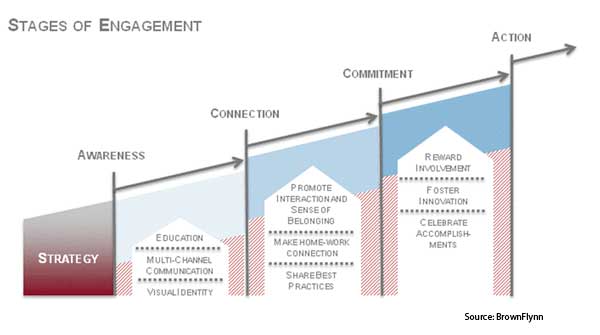 |
| Reviews and Templates for Expression We |
The four stages of engaging employees on sustainability

As a speaker at the recent Sustainability Leadership Forums in New York and Chicago, I had the opportunity to talk about ways employee engagement benefits corporations, from increasing employee retention and satisfaction, to positive financial impact. In fact, companies with sustainability programs built upon high employee engagement perform better and provide tangible upside to both the employees and the company, according to Net Impact’s Talent Report: “Workers who are able to make social or environmental impact on the job are more satisfied by 2:1.”
Furthermore, in the context of our regular column, employee engagement is a critical component of organizational change and development. Without the buy-in and support of employees, it is extremely difficult if not impossible to make any type of organizational change within a company.
According to the Gallup-Healthways Wellbeing Index, which each year surveys employees about their level of job satisfaction, the single most important way to engage workers is to enable them to make progress in meaningful work. They found that organizations that do this successfully have 3.9 times the earning per share growth compared to organizations with lesser engagement in the same industry.
So, how can your organization increase performance by engaging employees in sustainability? Companies are usually in one or more stages of the sustainability process, and employee engagement, at any given time. Although several stages may occur simultaneously and not necessarily in linear order, we will be providing you—in a three-part series—some guidelines and tips for making each stage, shown in the diagram below, a success.

- To start, you need a solid sustainability vision and strategy so employees have a clear understanding of the company’s future direction and why sustainability is important to the organization and their own futures. This foundational step is key and will be the glue that ties together all the other elements as the stages progress.
- Building on that clear vision and strategy, think next about how you can best “meet your employees where they are” to increase awareness and understanding of sustainability—not only what it means to your organization, but also what it means to them.
- Once you’ve connected with your employees on a more personal level and they feel a closer connection to the vision and strategy, you are well positioned to move them toward individual commitments, both at work and at home. This requires ongoing interaction, idea sharing and reinforcement of their value in the company’s sustainability journey.
- Finally, as an organization and its employees progress along the engagement continuum, they will achieve action-oriented results built upon a healthy level of competition, recognition and rewards.
But, the journey doesn’t stop there. As new employees join your company, others retire, and some change positions or feel they’ve done as much as they can in one area of sustainability, you will need to continually seek ways to engage and/or re-engage them. Through inspired leadership, effective communication, and openness to new ideas, you can retain and attract great talent while delivering positive returns for your company.
In next month’s column, we will cover in more detail the first phase of engagement, Awareness, and provide several creative ideas and examples of how companies have built an understanding of sustainability across diverse employee bases both nationally and globally.
|
|
|
|
Copyright 2011 Energy and Technical Services Ltd. All Rights Reserved. Energyts.com |